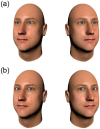Holistic processing of gaze cues during interocular suppression
- PMID: 35546346
- PMCID: PMC9095640
- DOI: 10.1038/s41598-022-11927-w
Holistic processing of gaze cues during interocular suppression
Abstract
Direct eye contact is preferentially processed over averted gaze and has been shown to gain privileged access to conscious awareness during interocular suppression. This advantage might be driven by local features associated with direct gaze, such as the amount of visible sclera. Alternatively, a holistic representation of gaze direction, which depends on the integration of head and eye information, might drive the effects. Resolving this question is interesting because it speaks to whether the processing of higher-level social information in the visual system, such as facial characteristics that rely on holistic processing, is dependent on conscious awareness. The Wollaston Illusion is a visual illusion that allows researchers to manipulate perceived gaze direction while keeping local eye features constant. Here we used this illusion to elucidate the driving factor facilitating the direct gaze advantage during interocular suppression. Using continuous flash suppression, we rendered Wollaston faces with direct and averted gaze (initially) invisible. These faces conveyed different gaze directions but contained identical eye regions. Our results showed clear evidence for a direct gaze advantage with Wollaston faces, indicating that holistic representations of gaze direction may drive the direct gaze advantage during interocular suppression.
© 2022. The Author(s).
Conflict of interest statement
The authors declare no competing interests.
Figures





Similar articles
-
Eye gaze adaptation under interocular suppression.J Vis. 2012 Jul 2;12(7):1. doi: 10.1167/12.7.1. J Vis. 2012. PMID: 22753441
-
Adaptation to other people's eye gaze reflects habituation of high-level perceptual representations.Cognition. 2018 Nov;180:82-90. doi: 10.1016/j.cognition.2018.07.005. Epub 2018 Jul 10. Cognition. 2018. PMID: 30007879
-
Gaze Direction Modulates the Relation between Neural Responses to Faces and Visual Awareness.J Neurosci. 2015 Sep 30;35(39):13287-99. doi: 10.1523/JNEUROSCI.0815-15.2015. J Neurosci. 2015. PMID: 26424878 Free PMC article.
-
[A review of face illusions].Brain Nerve. 2012 Jul;64(7):779-91. Brain Nerve. 2012. PMID: 22764350 Review. Japanese.
-
The importance of awareness in face processing: A critical review of interocular suppression studies.Behav Brain Res. 2023 Feb 2;437:114116. doi: 10.1016/j.bbr.2022.114116. Epub 2022 Sep 13. Behav Brain Res. 2023. PMID: 36113728 Review.
Cited by
-
Altered automatic gaze processing in older adults.Front Aging Neurosci. 2025 Jul 8;17:1592763. doi: 10.3389/fnagi.2025.1592763. eCollection 2025. Front Aging Neurosci. 2025. PMID: 40697357 Free PMC article.
References
-
- Baron-Cohen S, Campbell R, Karmiloff-Smith A, Grant J, Walker J. Are children with autism blind to the mentalistic significance of the eyes? Br. J. Dev. Psychol. 1995;13:379–398. doi: 10.1111/j.2044-835X.1995.tb00687.x. - DOI
MeSH terms
LinkOut - more resources
Full Text Sources

